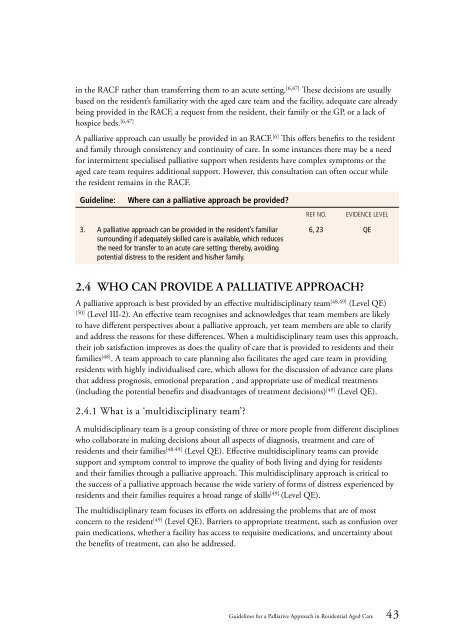Guidelines for a Palliative Approach in Residential Aged Care
Guidelines for a Palliative Approach in Residential Aged Care
Guidelines for a Palliative Approach in Residential Aged Care
Create successful ePaper yourself
Turn your PDF publications into a flip-book with our unique Google optimized e-Paper software.
<strong>in</strong> the RACF rather than transferr<strong>in</strong>g them to an acute sett<strong>in</strong>g. [6,47] These decisions are usually<br />
based on the resident’s familiarity with the aged care team and the facility, adequate care already<br />
be<strong>in</strong>g provided <strong>in</strong> the RACF, a request from the resident, their family or the GP, or a lack of<br />
hospice beds. [6,47]<br />
A palliative approach can usually be provided <strong>in</strong> an RACF. [6] This offers benefits to the resident<br />
and family through consistency and cont<strong>in</strong>uity of care. In some <strong>in</strong>stances there may be a need<br />
<strong>for</strong> <strong>in</strong>termittent specialised palliative support when residents have complex symptoms or the<br />
aged care team requires additional support. However, this consultation can often occur while<br />
the resident rema<strong>in</strong>s <strong>in</strong> the RACF.<br />
Guidel<strong>in</strong>e:<br />
Where can a palliative approach be provided?<br />
Ref No.<br />
Evidence level<br />
3. A palliative approach can be provided <strong>in</strong> the resident’s familiar<br />
surround<strong>in</strong>g if adequately skilled care is available, which reduces<br />
the need <strong>for</strong> transfer to an acute care sett<strong>in</strong>g; thereby, avoid<strong>in</strong>g<br />
potential distress to the resident and his/her family.<br />
6, 23 QE<br />
2.4 WHO CAN PROVIDE A PALLIATIVE APPROACH?<br />
A palliative approach is best provided by an effective multidiscipl<strong>in</strong>ary team [48,49] (Level QE)<br />
[50]<br />
(Level III-2). An effective team recognises and acknowledges that team members are likely<br />
to have different perspectives about a palliative approach, yet team members are able to clarify<br />
and address the reasons <strong>for</strong> these differences. When a multidiscipl<strong>in</strong>ary team uses this approach,<br />
their job satisfaction improves as does the quality of care that is provided to residents and their<br />
families [48] . A team approach to care plann<strong>in</strong>g also facilitates the aged care team <strong>in</strong> provid<strong>in</strong>g<br />
residents with highly <strong>in</strong>dividualised care, which allows <strong>for</strong> the discussion of advance care plans<br />
that address prognosis, emotional preparation , and appropriate use of medical treatments<br />
(<strong>in</strong>clud<strong>in</strong>g the potential benefits and disadvantages of treatment decisions) [49] (Level QE).<br />
2.4.1 What is a ‘multidiscipl<strong>in</strong>ary team’?<br />
A multidiscipl<strong>in</strong>ary team is a group consist<strong>in</strong>g of three or more people from different discipl<strong>in</strong>es<br />
who collaborate <strong>in</strong> mak<strong>in</strong>g decisions about all aspects of diagnosis, treatment and care of<br />
residents and their families [48,49] (Level QE). Effective multidiscipl<strong>in</strong>ary teams can provide<br />
support and symptom control to improve the quality of both liv<strong>in</strong>g and dy<strong>in</strong>g <strong>for</strong> residents<br />
and their families through a palliative approach. This multidiscipl<strong>in</strong>ary approach is critical to<br />
the success of a palliative approach because the wide variety of <strong>for</strong>ms of distress experienced by<br />
residents and their families requires a broad range of skills [49] (Level QE).<br />
The multidiscipl<strong>in</strong>ary team focuses its ef<strong>for</strong>ts on address<strong>in</strong>g the problems that are of most<br />
concern to the resident [49] (Level QE). Barriers to appropriate treatment, such as confusion over<br />
pa<strong>in</strong> medications, whether a facility has access to requisite medications, and uncerta<strong>in</strong>ty about<br />
the benefits of treatment, can also be addressed.<br />
<strong>Guidel<strong>in</strong>es</strong> <strong>for</strong> a <strong>Palliative</strong> <strong>Approach</strong> <strong>in</strong> <strong>Residential</strong> <strong>Aged</strong> <strong>Care</strong> 43
















